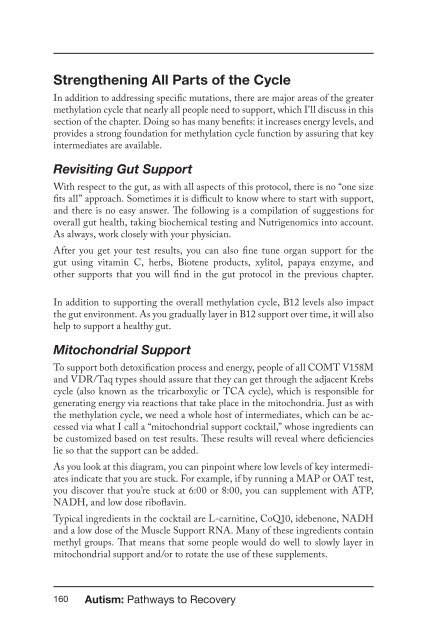3dT4E4Rnm
3dT4E4Rnm
3dT4E4Rnm
You also want an ePaper? Increase the reach of your titles
YUMPU automatically turns print PDFs into web optimized ePapers that Google loves.
Strengthening All Parts of the Cycle<br />
In addition to addressing specific mutations, there are major areas of the greater<br />
methylation cycle that nearly all people need to support, which I’ll discuss in this<br />
section of the chapter. Doing so has many benefits: it increases energy levels, and<br />
provides a strong foundation for methylation cycle function by assuring that key<br />
intermediates are available.<br />
Revisiting Gut Support<br />
With respect to the gut, as with all aspects of this protocol, there is no “one size<br />
fits all” approach. Sometimes it is difficult to know where to start with support,<br />
and there is no easy answer. The following is a compilation of suggestions for<br />
overall gut health, taking biochemical testing and Nutrigenomics into account.<br />
As always, work closely with your physician.<br />
After you get your test results, you can also fine tune organ support for the<br />
gut using vitamin C, herbs, Biotene products, xylitol, papaya enzyme, and<br />
other supports that you will find in the gut protocol in the previous chapter.<br />
In addition to supporting the overall methylation cycle, B12 levels also impact<br />
the gut environment. As you gradually layer in B12 support over time, it will also<br />
help to support a healthy gut.<br />
Mitochondrial Support<br />
To support both detoxification process and energy, people of all COMT V158M<br />
and VDR/Taq types should assure that they can get through the adjacent Krebs<br />
cycle (also known as the tricarboxylic or TCA cycle), which is responsible for<br />
generating energy via reactions that take place in the mitochondria. Just as with<br />
the methylation cycle, we need a whole host of intermediates, which can be accessed<br />
via what I call a “mitochondrial support cocktail,” whose ingredients can<br />
be customized based on test results. These results will reveal where deficiencies<br />
lie so that the support can be added.<br />
As you look at this diagram, you can pinpoint where low levels of key intermediates<br />
indicate that you are stuck. For example, if by running a MAP or OAT test,<br />
you discover that you’re stuck at 6:00 or 8:00, you can supplement with ATP,<br />
NADH, and low dose riboflavin.<br />
Typical ingredients in the cocktail are L-carnitine, CoQ10, idebenone, NADH<br />
and a low dose of the Muscle Support RNA. Many of these ingredients contain<br />
methyl groups. That means that some people would do well to slowly layer in<br />
mitochondrial support and/or to rotate the use of these supplements.<br />
160 Autism: Pathways to Recovery


